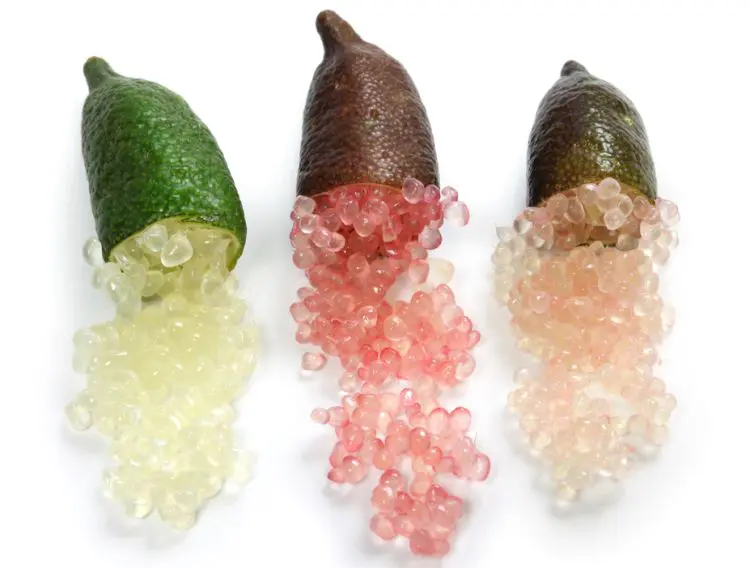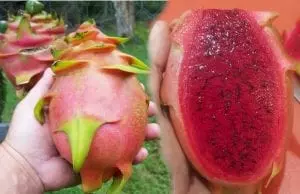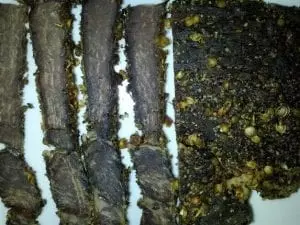Finger limes are an unusual citrus fruit which are native to subtropical Australia. They taste just like regular limes yet are unique in their texture and presentation; the insides look just like fruity caviar. Even in Australia, this is a gourmet fruit which can be hard to find & fetches high prices in retail markets. So let’s have a look at how to grow it at home!

What are Finger Limes?
Finger limes (citrus australasica) are a small citrus fruit native to subtropical south-east Queensland and northern New South Wales in Australia. They are called finger limes because their shape and size approximates that of your little finger. Fruits may grow up to 10cm (3″) long and 2-3cm (1″) in diameter. The skin may vary in colour from dark red to pale green to dark green, and the flesh looks like pale green or pink caviar. This evergreen tree occurs naturally as a rainforest understorey species with small dark green lobe-shaped leaves and sharp thorns at each leaf axil.
Finger lime trees can be grown from cuttings, but the overwhelming majority sold by nurseries and plant outlets are grafted. You can expect fruit from your finger lime tree within two years, but the crop may be light and the fruit quite small. The amount and size of the fruit will gradually increase as the tree ages.

Climate & Soil
Finger limes originate in the humid subtropics of Australia, so will do best in that climate (USDA zones 10-11). Cold climate growers will need to keep finger limes indoors, as this fruit tree will start to suffer when overnight winter temperatures drop below 10C (40F). They require at least six hours of full sun per day to fruit well, but I find that they’re grateful for morning rather than afternoon sun during a harsh summer. They are frost-sensitive and the fruit is susceptible to damage during high winds. This is a prickly plant which you won’t want to move too often, so choose your position carefully in relation to your climate.

Finger limes will cope with a variety of soil types as long as it is well-draining. As with all citrus trees, finger limes don’t like wet feet. To make your finger lime tree thrive, grow it in a loamy soil which is high in organic matter. A mildly acidic soil pH of 5-6.5 is thought to be best for finger lime trees. As finger limes are a young crop in terms of commercial production, little research has yet been done on their fertilisation requirements. At this stage it is thought that small amounts of fertiliser applied often is best, except during the period between flowering and fruit set (fertilising during this period may cause fruit to abort). Suitable fertilisers include worm castings, compost, or any general NPK fertiliser that is low in phosphorous.

Planting & Growing
The best time to plant out a finger lime tree is in early spring. This means you’re planting at the start of the main growth season, so this is the best possible timing to give it a good start.
Finger limes grow equally well in pots as in the ground. If planting in the ground, dig a hole at least twice as wide and deep as the root ball. Make sure the soil in the hole is adequately moist, & water before planting if necessary. Before placing your tree in the planting hole, gently tease out the root ball so that the young roots can make their way into the surrounding soil. Mix a handful of blood and bone (bonemeal) and a handful or 2 of citrus-specific fertiliser with your remaining soil, then backfill with this mixture. Make sure the graft point is well above the soil line, otherwise the rootstock can shoot and potentially overtake the tree.
This same method should be applied to planting in a pot. Remember to choose your pot size with forethought, as potting up a finger lime tree always comes with a prickly challenge! Mulch well, but keep the mulch at least 2″ away from the base of the tree, as this can cause collar rot.
Ongoing Care
Essentially, you can treat your finger lime tree much the same as most other citrus trees. If planted in the ground, water it twice a week (depending on the weather, of course), and allow to dry out just a little between waterings. Fertilise at least once a year at the start of spring with a citrus-specific fertiliser that contains trace elements.
Potted trees will always require more maintenance than those in the ground. This is because they have less soil reserves to draw on, less room to sprawl, and are more susceptible to temperature changes and drying out. I find that my potted finger lime trees (shown above) are fairly hungry and thirsty. They get a handful of fertiliser every 2 months or so and water about every 3 days. I vary the fertiliser according to what I have on hand- it may be a handful of all-purpose fertiliser, some rotted chicken manure, worm castings, dynamic lifter or worm tea. Be careful not to fertilise between flowering and fruit set, as this risks fruit drop.
Pruning can be done as needed. You might find the odd dead branch or part of a branch- just cut these off as they appear. As with any fruit tree, finger limes can be pruned in order to create & maintain a nice shape and an open canopy.

Harvesting & Storing
Colour is not always an indicator of fruit ripeness, as finger limes come in variety of colours. Fruit will come off the tree easily when its ripe. If you need to pull hard on the fruit, it isn’t ready yet. I have found that long-handled BBQ tongs are the best way to harvest finger limes. Not only are those thorns sharp, but they’re really hard to see!
Finger limes will keep in a paper bag in the fridge for about 3 weeks, and at room temperature on the bench for a week. They can be frozen effectively too, and the caviar texture will remain once thawed. To freeze, place the fruit in an airtight plastic bag or container.

Pests & Diseases
Like all citrus trees, finger limes are susceptible to a range of pests and diseases. These include aphids, sooty mould, caterpillars, scale insects, bronze orange bugs, mealy bugs and grasshoppers. Twig dieback can be caused by various fungal pathogens, and usually occurs during the rainy season. Chemical treatment isn’t necessary for this- just prune off damaged twigs and branches to prevent the infection from spreading.
I find that my finger limes aren’t as pest-prone as my other citrus trees, and I regularly spray them with a dipel solution throughout summer. Dipel (bacillus thuringiensis) is a bacteria, not a chemical pesticide, so is organic. This doesn’t eliminate all pests but it does help. You can also use chilli and/or garlic sprays, which will deter some pests.
Stink bugs (aka bronze orange bugs) appear in November/December in subtropical Australia, and should be picked off with tongs and either squashed or drowned in soapy water. They come out in force after 5pm, so at that time of year I do a daily patrol. These clingy sap-sucking insects can do a lot of damage very quickly, so it’s important to get them under control as soon as you see them.

Finger limes are also the natural host of the citrus gall wasp (bruchophahgus fellis), which create galls along stems. These look like woody lumps, and weaken the trees, reduce yield and may cause branch dieback. It’s important to check your trees for galls between June and September, and prune off any infected branches before the adult wasps emerge, which is usually by the end of August.
Look out for dark brown spots that could be a fungal disease called melanose. You also might find sooty mould, which looks like black soot has been dusted over the leaves. Sooty mould is the result of a secondary infection caused by insects such as aphids, scale, mealybugs, and whiteflies that secrete honeydew. Sooty mould is a fungus that feeds on the honeydew, covering the leaves and stems in a black sticky substance.












